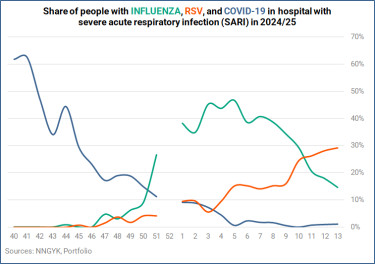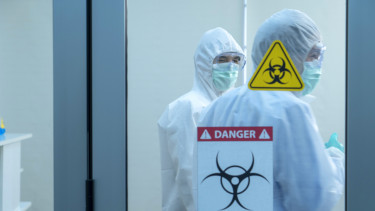Share of RSV in hospital admissions rises in Hungary

In terms of ARI we are worse off than a year ago, but in a better position than two years ago, while in terms of ILI we match the 2022/23 level and exceed last year's comparative figure.

The infection figures per 100,000 inhabitants show that in terms of ARI the situation is slightly better than in 2022/23 but worse than a year ago, while the ILI status is about the same as two years ago and worse than in any of the other respiratory seasons of the past 14 years.


The positivity rate for COVID-19 has been around 0% since the 8th week, and it has come down to 19.9% for influenza but rose to 12.2% from 10% for respiratory syncytial virus (RSV).

On the 13th week, there were 185 people in hospital with severe acute respiratory infection (SARI), down from 213 a week earlier. The situation was better a year ago (127), but worse two years ago (201). 29 patients required intensive care (15.7% of all SARI patients), an increase from 24 on the 12th week (11.3%).

The share of RSV infections among those admitted to a hospital with SARI rose to 29.2%, up from 28.2%, which compares with 26% a year ago, and only 7.5% two years ago. The percentage of SARI patients with influenza dropped to 14.6% from 17.8% on the 12th week, which compares with 6.3% in 2023/24 and 9.5% in 2022/23.

Almost half (48.1%) of the SARI patients were less than 2 years old on the 13th week, while the proportion of this age group remains high (almost 80%) among SARI patients admitted with RSV. The situation was only slightly better a year ago, when 44.1% of SARI patients and 78.8% of RSV patients were under two years old.


In the first three months of 2025, the number of reported cases of suspected hepatitis A infection increased 7.5 times compared to the same period last year, according to the latest data by the National Centre for Public Health and Pharmacy (NNGYK). The most affected areas are Budapest, Pest and Fejér counties. The number of new infections (47) in the 12th week of 2025 was the highest so far this year.

Earlier this week, he NNGYK also released the number of suspected pertussis cases for the 12th week, showing a drop to 6 from 12 cases on the 11th week. Abou 29% of the infections were in infants, 45.8% were in children up to 14 years of age, 52.4% were in children up to 19 years of age, and more than 13% of the infections were in people over 60 years of age.

Cover image (for illustration purposes only): Getty Images






